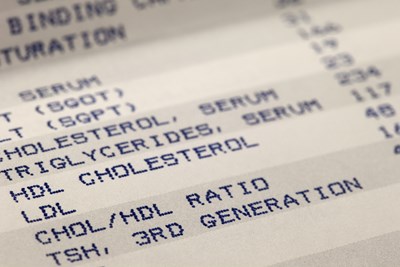A triglyceride (TG, triacylglycerol TAG, or triacylglyceride) is a chemical compound made up of glycerol and three fatty acids. It is the main component of vegetable oil and animal fats. The glycerol molecule has three hydroxyl (HO-) groups, and each fatty acid has a carboxyl group (COOH). Many kinds of triglycerides are known.
Most natural fats contain a complex mixture of individual triglycerides, and because of this, they melt over a wide range of temperatures. They are a type of lipid (organic compound) found in the blood that the body creates to store extra calories it doesn't need. The body stores them in fat cells. After some time, hormones release the stored triglycerides for energy between meals. One who regularly eats more calories than he or she burns, especially abundant calories like carbohydrates and fats, can build up triglycerides, resulting in, hypertriglyceridemia. A healthy triglyceride level is less than 150 milligrams per deciliter or less than 1.7 millimoles per liter. A high level is 200-499 milligrams per deciliter. Triglycerides and cholesterol are separate types of lipids circulating in the blood. Where triglycerides are the calorie-storing lipids, cholesterol is used to build cells and certain hormones.
Triglycerides Symptoms
High triglycerides do not cause symptoms. Instead, a high triglyceride count is more often a symptom of other conditions that increase the risk of heart disease and stroke, including obesity. Metabolic syndrome, a cluster of conditions that includes too much fat around the waist, high blood pressure, high triglycerides, high blood sugar and abnormal cholesterol levels, is also a risk. Sometimes high triglycerides are a sign of poorly controlled type-2 diabetes, low levels of thyroid hormones (hypothyroidism), liver or kidney disease, or rare genetic conditions that affect how the body converts fat into energy. High triglycerides can also be a side effect of medications such as beta blockers, birth control pills, diuretics, steroids, or tamoxifen (a breast cancer drug). Although the reason is unknown, high triglycerides may contribute to hardening of the arteries and thickening of the artery walls (atherosclerosis), which is what increases the risk of stroke, heart attack, and heart disease. Triglycerides are measured using a common test called a lipid panel, which is the same blood test used to check cholesterol levels. The levels are checked after an overnight fast, as fat from a meal can artificially raise the triglyceride levels on the test. The American Heart Association recommends that everyone over the age of 20 be tested.
Triglycerides Treatment
The best high triglycerides treatment is by making changes toward a healthier lifestyle through diet and exercise. Moderate physical activity five or more days a week can help lower levels as well as lead to weight loss, which lowers both triglycerides and cholesterol. Reducing saturated fat, trans fat, and cholesterol intake can improve triglyceride levels as well. Alcohol has a strong effect on triglyceride levels. Consuming more than one drink per day for women, or two for men, can considerably raise triglyceride levels, and some with high triglycerides may need to remove alcohol from their diet completely. One should cut back on calories, because extra calories are converted to triglycerides stored in body fat, and eliminate trans fat intake, which are prevalent in fried and commercially baked foods. Eating fish high in omega-3 fatty acids, instead of red meat, which is high in saturated fat, can help maintain healthy triglyceride levels. Some examples are mackerel, lake trout, herring, sardines, albacore tuna, and salmon. Medicine may be prescribed for those with dangerously high triglycerides. Several medications include fibrates, nicotinic acid (Niacin), high doses of omega-3, and Lovaza. Triglyceride treatment will not only lower levels but likely improve overall health, fitness, cholesterol levels, and risk of heart disease.



